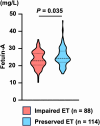Reduced Fetuin-A Levels Are Associated With Exercise Intolerance and Predict the Risk of Adverse Outcomes in Patients With Heart Failure: The Role of Cardiac-Hepatic-Peripheral Interaction
- PMID: 39189483
- PMCID: PMC11646492
- DOI: 10.1161/JAHA.124.035139
Reduced Fetuin-A Levels Are Associated With Exercise Intolerance and Predict the Risk of Adverse Outcomes in Patients With Heart Failure: The Role of Cardiac-Hepatic-Peripheral Interaction
Abstract
Background: Exercise intolerance in heart failure arises from multifactorial pathophysiological mechanisms. Hepatokines, liver-synthesized molecules, regulate systemic metabolisms in peripheral tissues. We previously identified the hepatokine fetuin-A as being linked to liver hypoperfusion in heart failure. Here, we investigated the role of fetuin-A in connecting cardiac-hepatic-peripheral interaction.
Methods and results: We conducted a prospective study involving 202 consecutive hospitalized patients (mean age, 56.8 years; 76.2% men) with heart failure who underwent cardiopulmonary exercise testing. We measured the serum concentration of fetuin-A by ELISA. Correlation analysis revealed a negative association between fetuin-A levels and the ratio of minimum minute ventilation to carbon dioxide production, its slope, and a tendency toward a positive correlation with peak oxygen uptake. Patients with impaired exercise tolerance exhibited lower fetuin-A levels. During a median follow-up of 1045 days, 18.3% experienced cardiac events, including 4 cardiac deaths and 33 cases of worsening heart failure. Classification and regression tree analysis identified a high-risk subgroup with lower fetuin-A (<24.3 mg/L) and impaired exercise tolerance (peak oxygen uptake<14.2 mL/kg per min). Kaplan-Meier analysis revealed that this subgroup had the highest risk of cardiac events. In a multivariable Cox proportional hazard model, the combination of lower fetuin-A and exercise intolerance was independently associated with increased risks of cardiac events.
Conclusions: Reduced circulating fetuin-A levels were associated with exercise intolerance in heart failure patients. Fetuin-A could emerge as a target implicated in exercise capacity connecting cardiac-hepatic-peripheral interaction and as a valuable biomarker for predicting prognosis when combined with peak oxygen uptake.
Keywords: biomarker; exercise intolerance; fetuin‐A; heart failure; hepatokine.
Figures



References
-
- O'Connor CM, Whellan DJ, Lee KL, Keteyian SJ, Cooper LS, Ellis SJ, Leifer ES, Kraus WE, Kitzman DW, Blumenthal JA, et al. Efficacy and safety of exercise training in patients with chronic heart failure: HF‐ACTION randomized controlled trial. JAMA. 2009;301:1439–1450. doi: 10.1001/jama.2009.454 - DOI - PMC - PubMed
-
- Pandey A, Parashar A, Kumbhani D, Agarwal S, Garg J, Kitzman D, Levine B, Drazner M, Berry J. Exercise training in patients with heart failure and preserved ejection fraction: meta‐analysis of randomized control trials. Circ Heart Fail. 2015;8:33–40. doi: 10.1161/CIRCHEARTFAILURE.114.001615 - DOI - PMC - PubMed
MeSH terms
Substances
LinkOut - more resources
Full Text Sources
Medical
Miscellaneous

